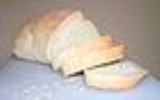
White bread
Encyclopedia

Wheat flour
Wheat flour is a powder made from the grinding of wheat used for human consumption. More wheat flour is produced than any other flour. Wheat varieties are called "clean," "white," or "brown" if they have high gluten content, and they are called "soft" or "weak" flour if gluten content is low...
from which the bran
Bran
Bran is the hard outer layer of grain and consists of combined aleurone and pericarp. Along with germ, it is an integral part of whole grains, and is often produced as a by-product of milling in the production of refined grains. When bran is removed from grains, the grains lose a portion of their...
and the germ
Cereal germ
The germ of a cereal is the reproductive part that germinates to grow into a plant; it is the embryo of the seed. Along with bran, germ is often a by-product of the milling that produces refined grain products. Cereal grains and their components, such as wheat germ, rice bran, and maize may be used...
have been removed through a process known as milling. Milling gives white flour a longer shelf life by removing the bran which contains oil, allowing products made with it, like white bread, the ability to survive storage and transit times. In addition, the flour used in white bread is often bleached using potassium bromate
Potassium bromate
Potassium bromate , is a bromate of potassium and takes the form of white crystals or powder.-Uses in baking:Potassium bromate is typically used as a flour improver , strengthening the dough and allowing higher rising. It is an oxidizing agent, and under the right conditions, will be completely...
or chlorine dioxide
Chlorine dioxide
Chlorine dioxide is a chemical compound with the formula ClO2. This yellowish-green gas crystallizes as bright orange crystals at −59 °C. As one of several oxides of chlorine, it is a potent and useful oxidizing agent used in water treatment and in bleaching....
gas to remove any slight yellow color and make its baking properties more predictable.
While the milling process helps improve white flour's shelf life, it does remove nutrients like some dietary fiber
Dietary fiber
Dietary fiber, dietary fibre, or sometimes roughage is the indigestible portion of plant foods having two main components:* soluble fiber that is readily fermented in the colon into gases and physiologically active byproducts, and* insoluble fiber that is metabolically inert, absorbing water as it...
, iron, B vitamins and micronutrients. Since 1941, however, fortification of white flour-based products with some of the nutrients lost in milling, like thiamin, riboflavin, niacin, and iron was mandated by the US government in response to the vast nutrient deficiencies seen in US military recruits at the start of World War II. This fortification led to nearly universal eradication of deficiency diseases in the US, such as pellagra
Pellagra
Pellagra is a vitamin deficiency disease most commonly caused by a chronic lack of niacin in the diet. It can be caused by decreased intake of niacin or tryptophan, and possibly by excessive intake of leucine. It may also result from alterations in protein metabolism in disorders such as carcinoid...
and beriberi
Beriberi
Beriberi is a nervous system ailment caused by a thiamine deficiency in the diet. Thiamine is involved in the breakdown of energy molecules such as glucose and is also found on the membranes of neurons...
(deficiencies of niacin and thiamine, respectively) and white bread continues to be an important source of these key vitamins to this day.
Folic acid
Folic acid
Folic acid and folate , as well as pteroyl-L-glutamic acid, pteroyl-L-glutamate, and pteroylmonoglutamic acid are forms of the water-soluble vitamin B9...
is another nutrient that some governments have mandated is added to enriched grains like white bread. In the US and Canada, these grains have been fortified with mandatory levels of folic acid since 1998 because of its important role in preventing birth defects. Since fortification began, the rate of neural tube defects has decreased by approximately one-third in the US, resulting in a cost savings of an estimated $33.7-125 million annually.

